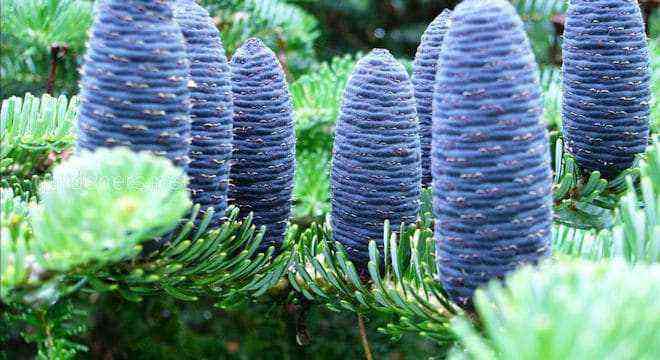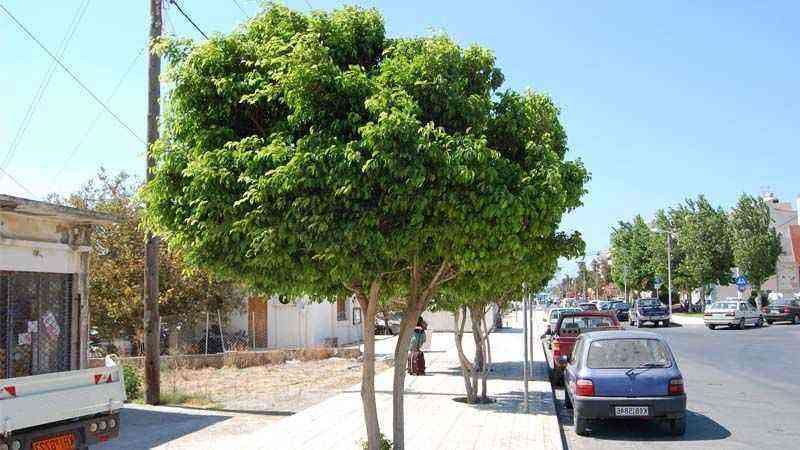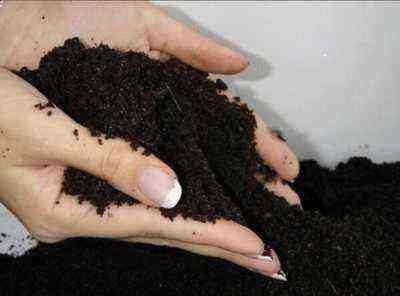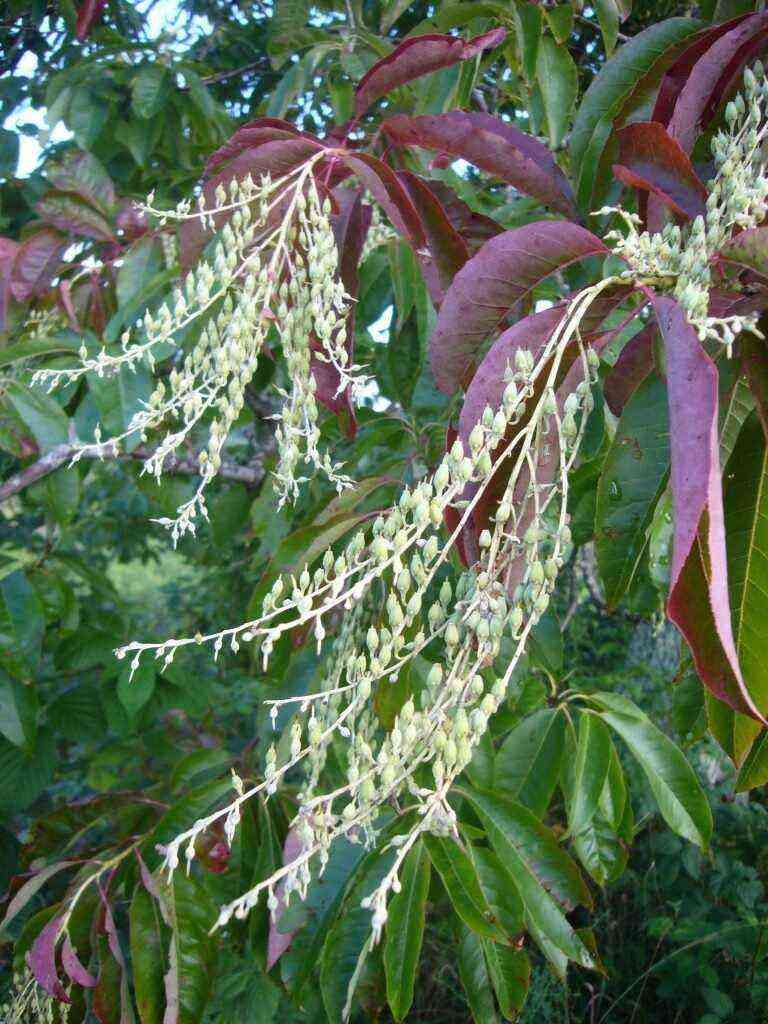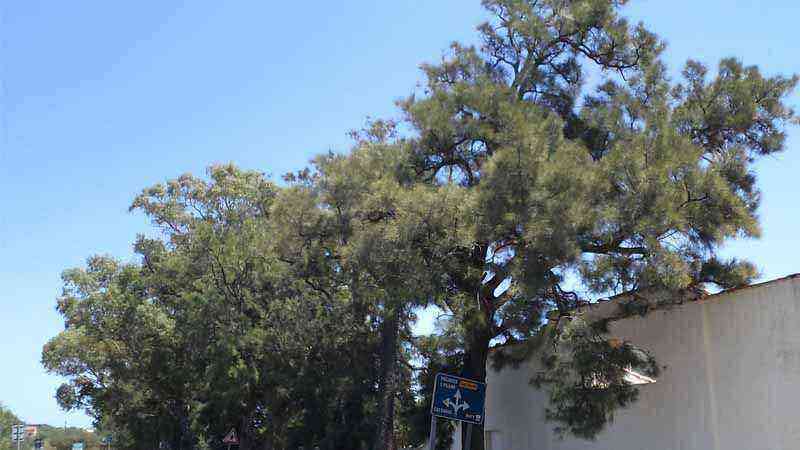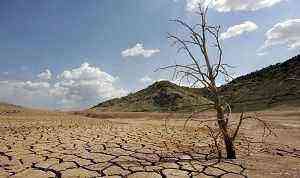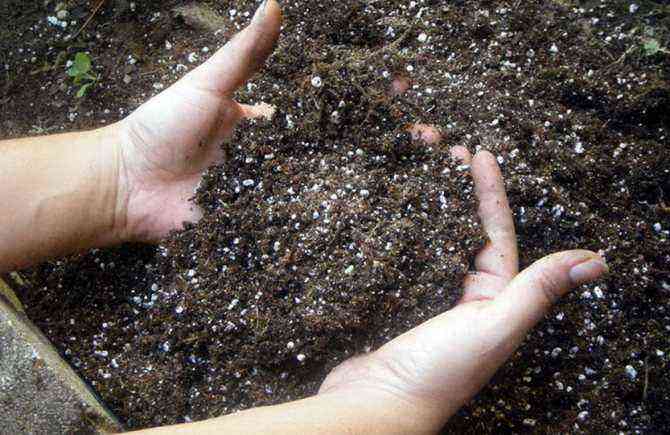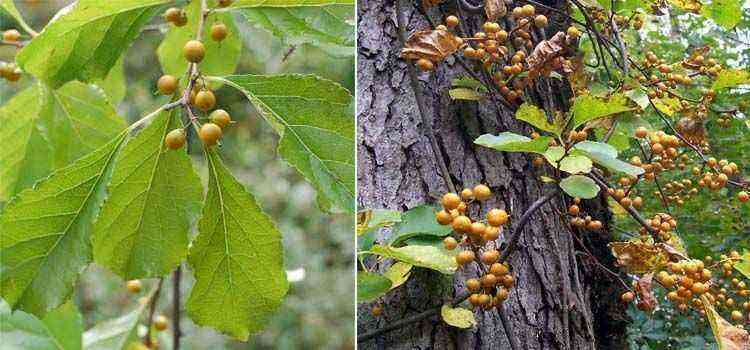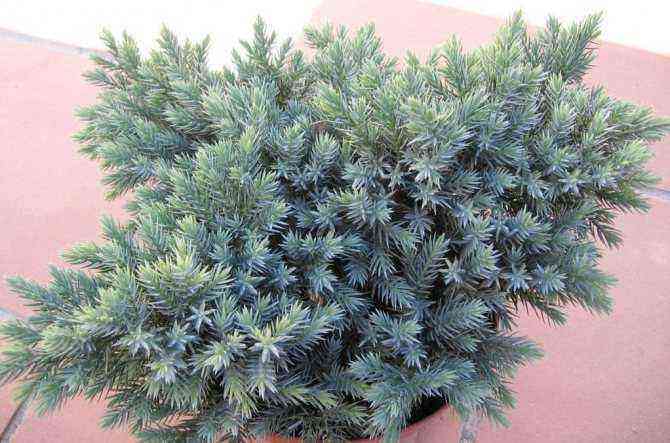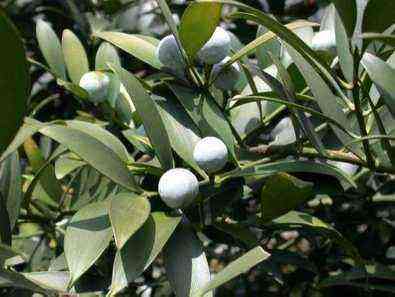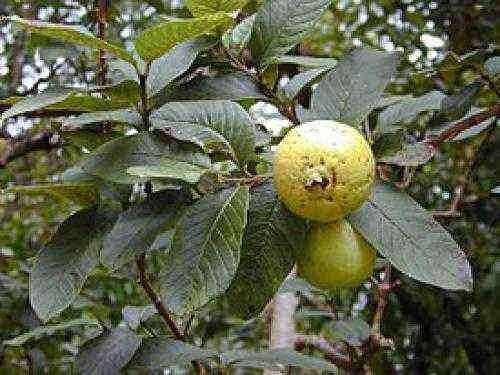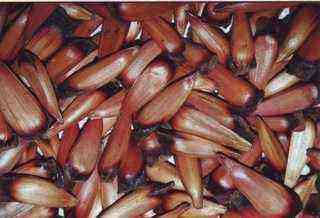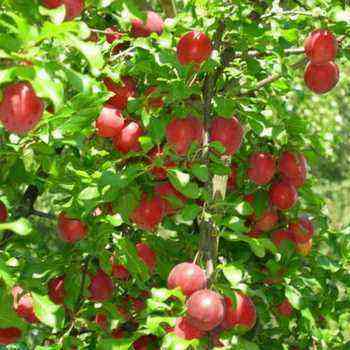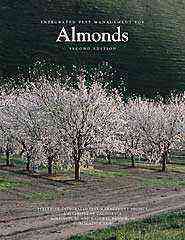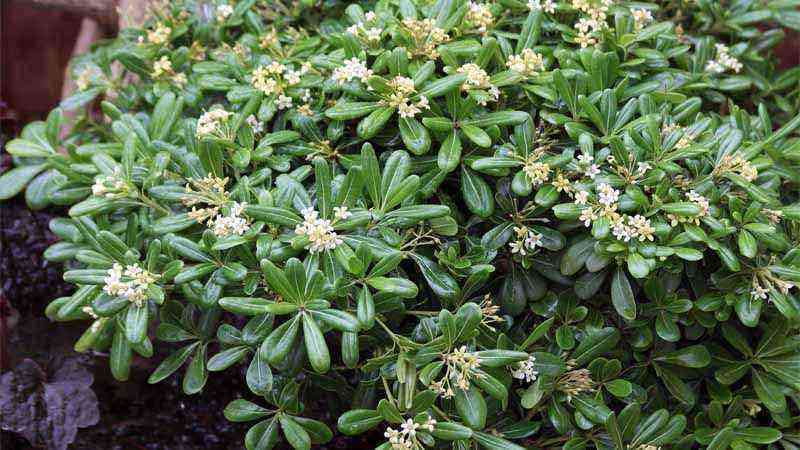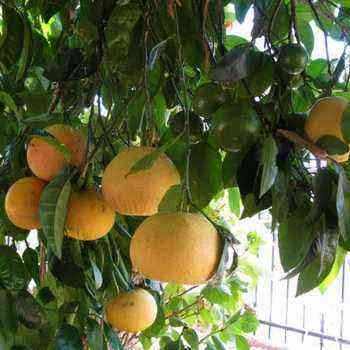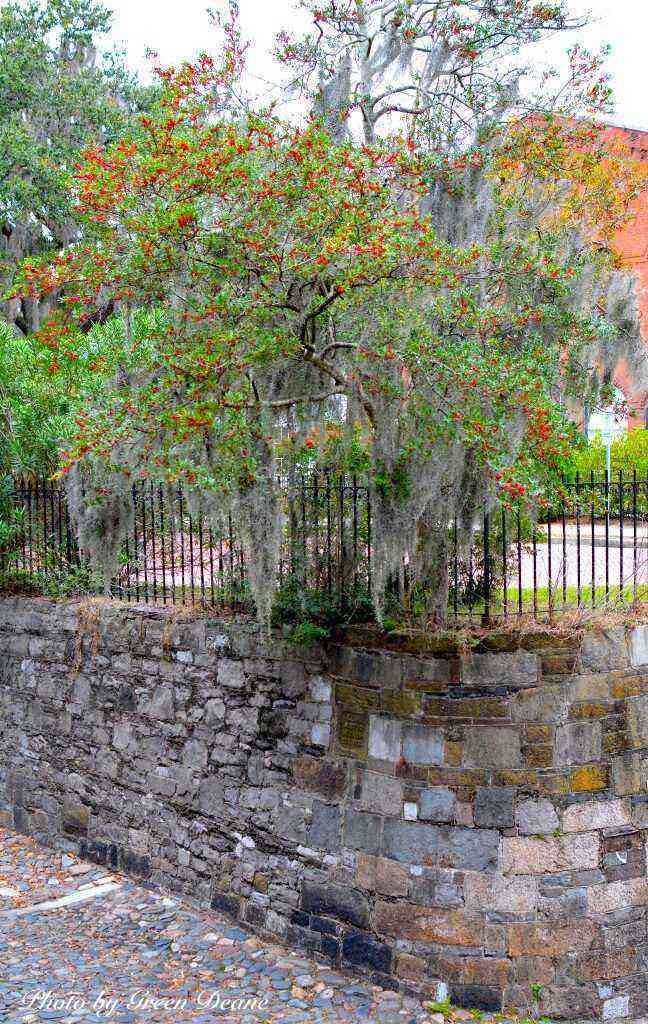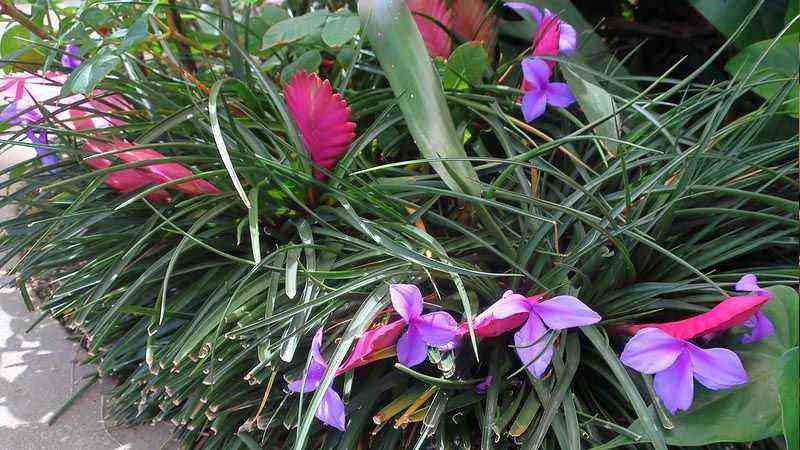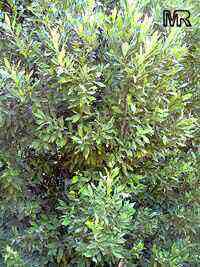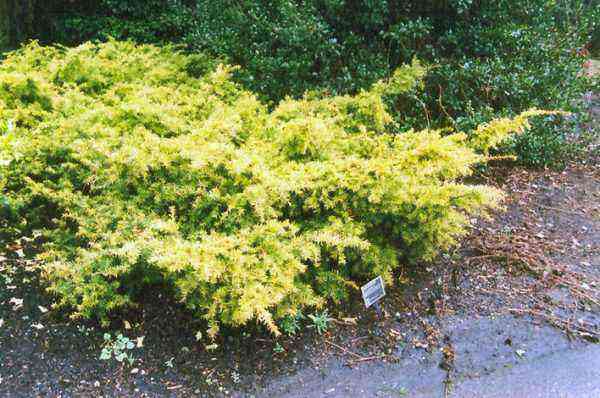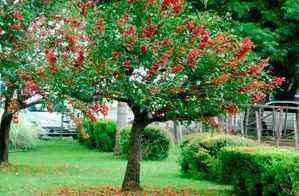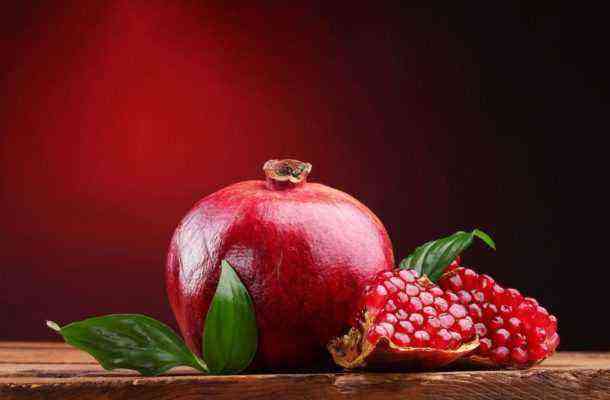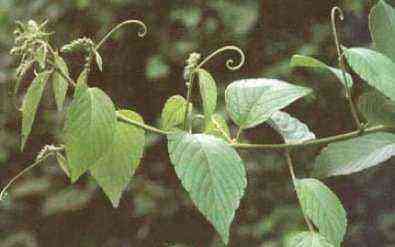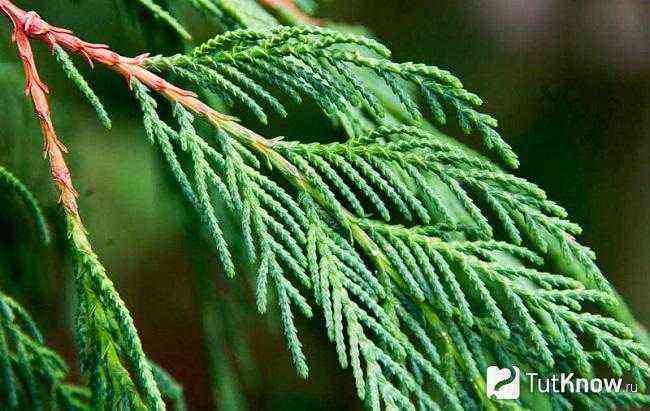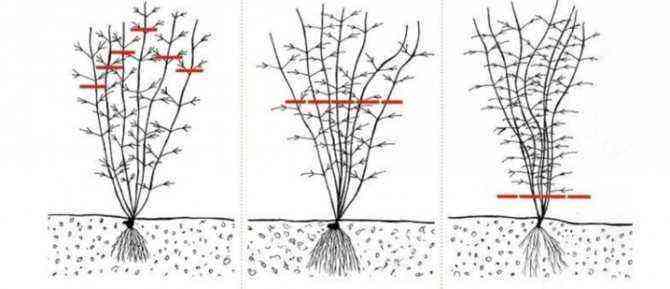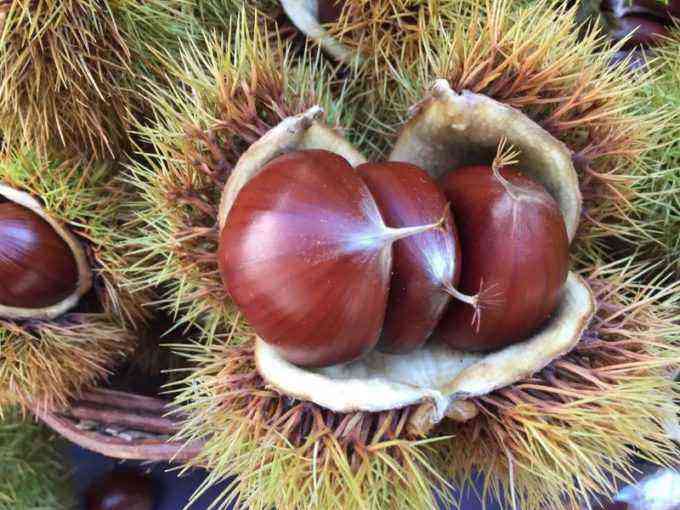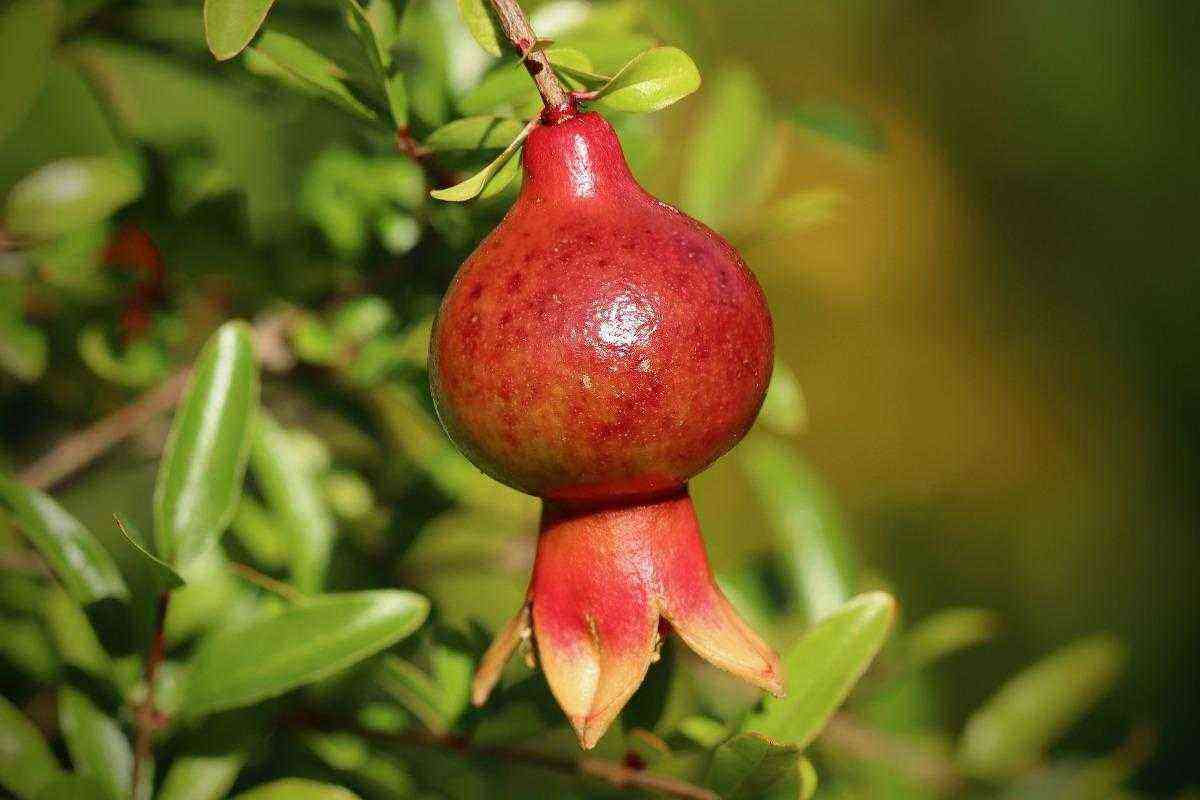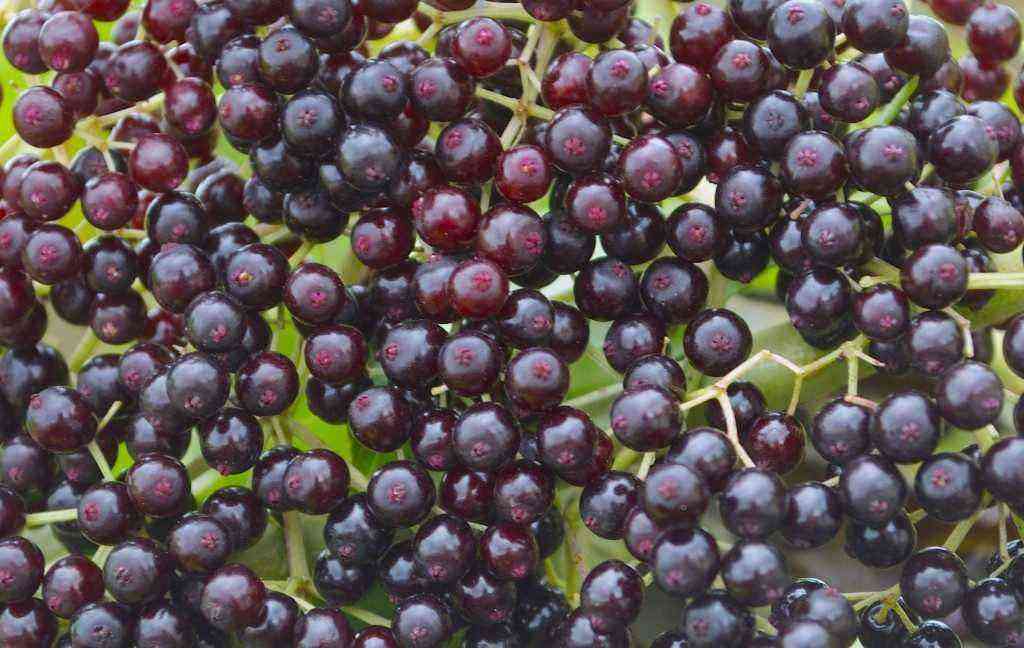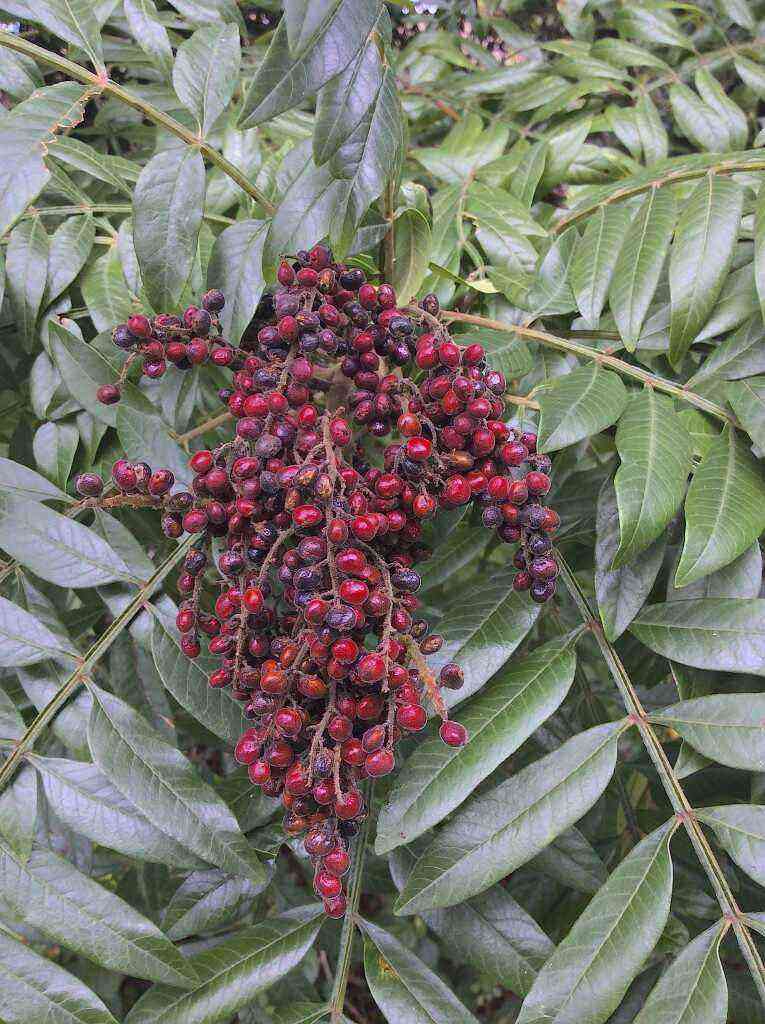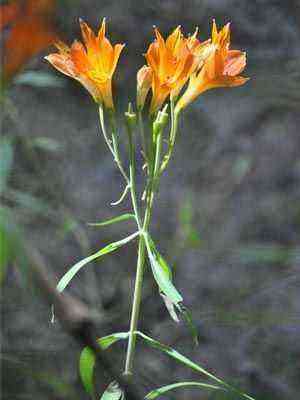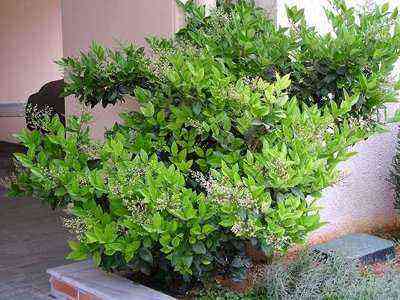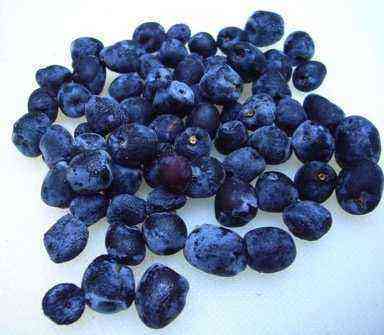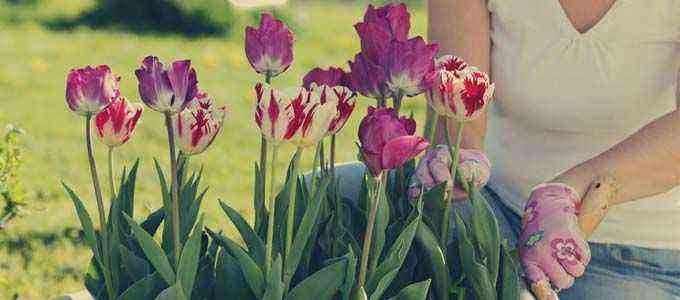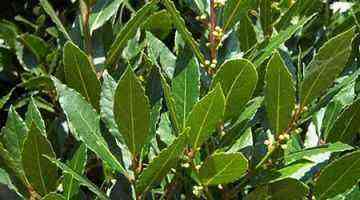What does a fir look like photo and description of an evergreen tree
Fir is a coniferous evergreen crop. The culture belongs to the Pine family. The plant is considered secular, since its life span reaches half a millennium. Fir, depending on the variety, can be in the form of a bite or a tree. The area where the fir grows also affects the height of the crop. So, the height of the trunk can exceed 80 m, and the length of shrubs rarely reaches 10 meters. The appearance of the tree is pyramidal.
The plant’s rhizome is pivotal, located mainly in the upper layer of the soil. Fir roots are quite spreading, most of them lie at a depth of up to 2 meters in the ground. The roots extend from the base of the stem of the culture, spreading in different directions. The thickness of the roots depends on the age of the tree. So, the thickness of the rhizome of a young tree does not exceed 3 cm, and the diameter of the rhizome of an adult perennial often reaches 15 cm.
A tree trunk grows from the base of the rhizome. The trunk is covered with gray-brown bark. Young crops have smooth brown bark. With age, the surface of the trunk becomes woody, covered with longitudinal cracks, the bark becomes tough and hard. The peculiarity of fir is the absence of resin passages inside the wood. The resin is located in the bark. The trunk diameter of old, centuries-old trees can reach 3,5 meters.
On the surface of the trunk, starting practically from the base, stems appear. The length of the stems decreases as it approaches the apex. The stems are located almost perpendicular to the central trunk. The stems are strongly branched, into small twigs covered with smooth bark. The length of the stems at the base reaches 3 meters, while towards the top of the tree, the stems do not exceed a meter in length.
The surface of the stems and small branches of the tree is covered with needles. The needles cover most of the tree. The needles are attached to the base with a narrowed petiole. The needles are thin, flat. The surface of the needles is even and smooth, has a dark green tint or silvery. On the shoots, the needles are located spirally. The length of the needles reaches 5 cm. The needles have 2 light stripes on the bottom. There are resin buds between the needles on the new branches. The needles on the shoots are arranged singly, comb-like. The arrangement of the needles is alternate.
There are male and female cones on the fir at the same time. You can tell the sex of the cones by looking at their location on the plant. Males grow in groups, several in one place. Womens – separately. At the same time, male cones have a yellowish tint. This is due to the accumulation of pollen inside the fetus. Female cones are colored first purple, then brown. The female fruits are oval, while the male ones hang from the tree in the form of small rounded earrings. Cones are held by small petioles attached to the surface of the shoot. The size of the fruit is about 10 cm. Scaly cones. There is a small fruit under each scale. At first, the scales cover the fir seeds tightly, but by the beginning of autumn the cone disintegrates. At the same time, the seeds fly in different directions.
How to distinguish fir from spruce?
The fir tree (the description will be presented to your attention below) looks like a spruce, and an inexperienced person can easily make a mistake. However, the differences between these two plants are significant.
What does a fir tree look like? His crown is located at the base of the trunk, in contrast to spruce and pine. The needles are very soft, with long and flat needles. The spruce’s needles are hard, short and prickly. Each needle on the underside of the fir has two white stripes. The needles are slightly sharp, located on reproductive shoots, or rounded towards the end (such needles grow on vegetative branches).
The needles on the branches of fir grows only on two sides, so the shoots themselves look “flat”. In the spruce, the needles are located on the shoot in a circular manner.
Fir cones are of two types – the male ones rather resemble earrings made of small “flowers”. Female cones are large, cylindrical or ovoid, growing upward, as if “sitting” on a branch. Spruce cones usually hang down.
In winter, fir needles remain bright, unlike other conifers, the needles of which fade slightly in the cold season. If you cut off a fir branch and bring it home, the needles will not dry out and will not fall off, unlike Christmas tree needles. Therefore, fir is more often used in home decoration for the New Year holidays, they create beautiful compositions from twigs that can look good for a very long time.
Distribution
Fir lives in almost any region. The culture is found in the southern and northern regions, countries with tropical, subtropical and temperate climates. In some regions, there are fir forests, which occupy about 20 million hectares of the entire area. The culture is planted in regions with a northern climate. You can meet the varieties in Mexico, El Salvador. In Russia, fir is found in almost all regions. In Siberia, fir lives in the Northern Hemisphere, along the banks of the Yenisei River.
Fir is an unpretentious plant that lives in coastal areas and in mountainous areas. Various types of crops are highly resistant to frost and can easily tolerate drought. Fir can grow both as a separate crop and as fir forests. The culture is not demanding on living conditions, but it grows only in places with fertile soil.
Where does Korean fir grow
Korean fir or Abies Koreana is found naturally on the Korean Peninsula. The tree prefers southern regions and heights from 1000 to 1900 m. The plant forms clean forests or lives in the vicinity of ayan spruce and stone birch.
Fir appeared in Europe in 1905. In the USSR, the tree has been known since 1939. Its features are being studied by the workers of the Botanical Garden BIN in St. Petersburg. In Russia, Korean species are only gaining popularity. They can be grown in warm regions, the middle lane, in Siberia, the Urals and the Far East.
Description of species and varieties
The species diversity includes about 50 different varieties of culture. A variety of varieties allows you to choose a plant that is most suitable for growing conditions in a particular area. Cultures have their own characteristics and external features.
European abies alba
The most popular species found throughout Central Europe. The cultivated plantations of this type of fir form fir forests. It is a perennial plant, up to 65 meters high, pyramidal in shape. The plant is completely covered with dense needle-like foliage.
The plant has a dense crown, consisting of shoots and densely growing needles. The crown has a dark green color, the length of the needles does not exceed 3 cm. Unlike other species, the culture does not have stripes on the needles. Between the needles, resinous buds grow on the shoots, inside which there is a thick yellow resin.
Fir forms cones in the spring. Male cones hang from the shoots, painted in a yellowish brown tint. Female cones are large enough – the length of a young cone can reach 16 cm. Females are located on the surface vertically from the shoot, attached to the base with a small petiole.
Balsamic abies balsamea
The habitat of wild trees of this species is considered to be the shores of North America, where the culture is most common. It is a tree up to 30 meters long with a conical crown. The plant is relatively frost-hardy, can withstand frosts up to 20 degrees. The culture is found along the shores of the Pacific and Atlantic Ocean.
The crown of the tree is translucent, a fairly dense and dense tree trunk reaches a meter in diameter. The plant, unlike other representatives of the species, has rather small needles. The length of the needles does not exceed 2 cm. The needles are flat, attached to young shoots with the help of small petioles. The needles are narrowed to the bottom and top. The surface of the needles is soft, due to which the culture does not have as sharpness as other conifers.
Balsamic nana abies balsamea nana
A variety that is considered one of the lowest representatives of fir. The plant is represented by a small shrub spreading along the surface of the earth. The bushes reach half a meter in height, and grow 3 meters in width. The difference between the culture lies in the thin and small green needles, which do not exceed a centimeter in length. Young needles have light green shades. Therefore, in spring and early summer, you can observe multi-colored shades – inside the crown is covered with thick dark needles, and outside the crown is covered with a layer of light brushes.
Balsamic piccolo abies balsamea piccollo
A small round bush. The crown diameter of a culture rarely exceeds half a meter. The culture has dense shoots located close to each other, abundantly covered with dark needles. The ends of the shoots are covered with young, light brushes of needles, on which small cones appear by the spring. The length of the needles in this species is approximately 1 cm.

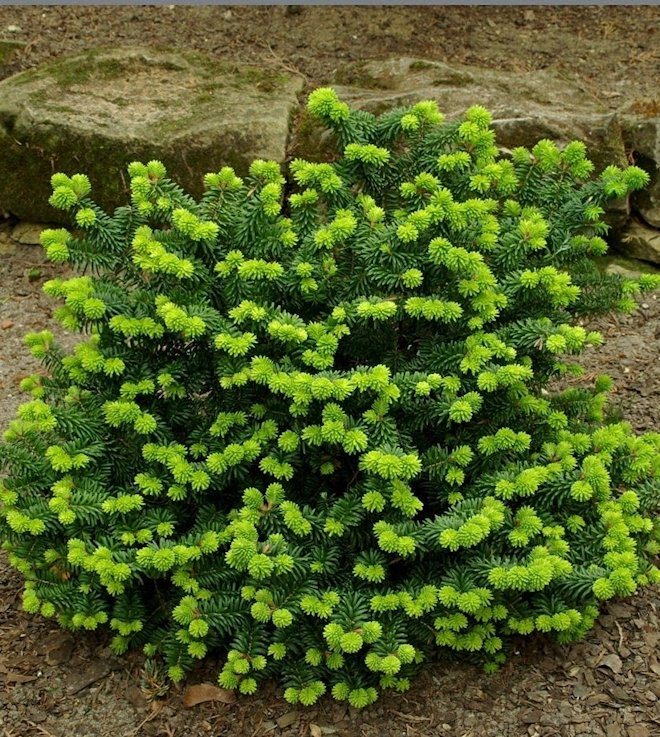
Plain abies concolor
A fir growing as a single-stemmed tree. The plant is tall, the crown height can reach 60 meters, and the trunk width of old trees can exceed 2 meters. The habitat of culture is the western regions of America. In these areas, the plant is effectively used in industry. The trunk is covered with smooth bark. Old trees on the bark have even vertical cracks, which increase every year.
Branches located horizontally on the trunk are covered with densely spaced shoots. As you reach the top, the length of the stems decreases. The stems are completely covered with twigs and needles. The needles are quite long, up to 5 cm, of a silvery-blue hue. Long needles on the plant are crescent-shaped.
In the spring, young cones form on the tree. Male cones of a bluish tint gather in groups, hang from twigs. While females are located almost vertically, they are colored first in green, then in brown. The length of female cones reaches 12 cm.
Одноцветная abies concolor violacea
A hybrid variety of fir. Unlike other varieties, this species has an unusual color of needles – depending on sunlight, fir can take on a violet-blue hue. The plant has good resistance to drought and frost, easily tolerates wind and gas-polluted city air.
Represents trees up to 8 meters high. The culture grows and develops quite quickly. The culture prefers to grow as a single tree that needs a lot of light and room for roots. The crown of the tree is pyramidal, dense and dense. The branches are located horizontally on the trunk, so the diameter of the lower branches forming the crown reaches 5 meters.
Korean abies koreana
A plant of medium size, typical of fir. The tree grows slowly and forms shoots. The height of trees by the age of 30 rarely exceeds 4 meters. The peculiarity of the plant is the presence of bluish cones hanging from branches almost all year round, or erect on the branches. The crown of the tree consists of dense shiny needles, a dark green shade. Even on young individuals, cones appear, which give the culture an unusual look.
The difference between the variety lies in the need for additional care. The plant requires increased sunlight, therefore it is planted mainly separately from other tall crops. The plant is recommended to be planted in small areas that do not have other trees.
Korean abies koreana brefolia
A variety of Korean fir, the peculiarity of which is the presence of asymmetrically located branches on the crown. It is a dwarf fir variety, the height of which does not exceed one meter. The plant has solid brown shoots. The hybrid is considered to be very finicky in growing conditions. To get a neat bush, you need to provide regular light and fertile soil.
Korean abies koreana silberlocke
A shrub variety of medium size and slow growth. A conical fir, after reaching the age of 10 years, begins to grow not in height, but in width. At the age of 30, the plant has a height of up to 4 meters, while the width of the bush can exceed 1,5 meters. The peculiarity of this type of fir is the presence of flexible shoots with a curved shape.
Mountain abies lasiocarpa
The variety is also called subalpine. It is a small tree, up to 5 meters high, growing in a pyramidal shape. The trees are centuries old, the average lifespan of individuals is about 400 years. The culture in its natural environment is found in North America. The plant is highly resistant to frost. Fir branches grow in different directions, forming a wide crown, the diameter of which at the bottom of the tree can exceed 2,5 m.
The plant has a rich green, translucent crown, which in young plants has a bluish tint, and darkens with age. Unlike other species, this species has small, practically invisible cones that are not of decorative value. Despite the high proliferation of branches, the tree has a slow growth. Therefore, the tree is quite fluffy and spreading, has a dense crown.
Caucasian abies nordmanniana
Trees up to 30 meters high with an even cone-shaped crown. The decorativeness of the culture lies in the fluffy raised branches, which have almost the same dimensions along the entire diameter, forming an even pyramid. The branches are covered with an abundance of green needles. The plant, unlike other representatives of the species, grows quite quickly; at the age of thirty, the size of a fir can exceed 10 meters.
The needles form an even crown over the entire size of the tree. The plant is covered with green needles with blue needles up to 4 cm in size. The needles are located separately, alternately attaching to the young shoot. After the needles are formed on the foliage, it remains on the tree for a long time. The decorativeness of fir is the appearance of silvery shades of needles in windy weather.
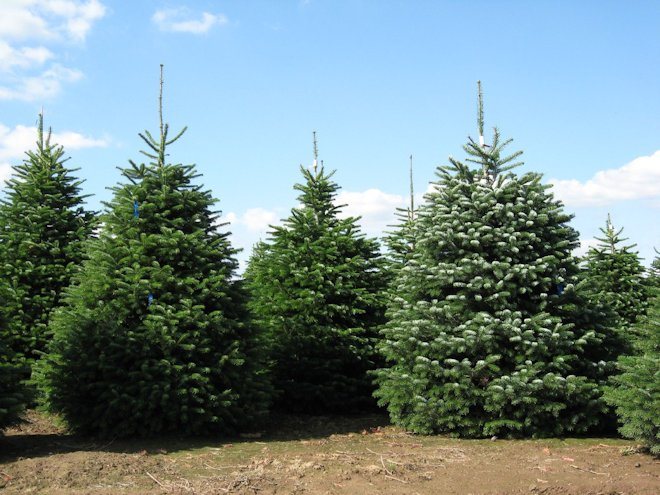
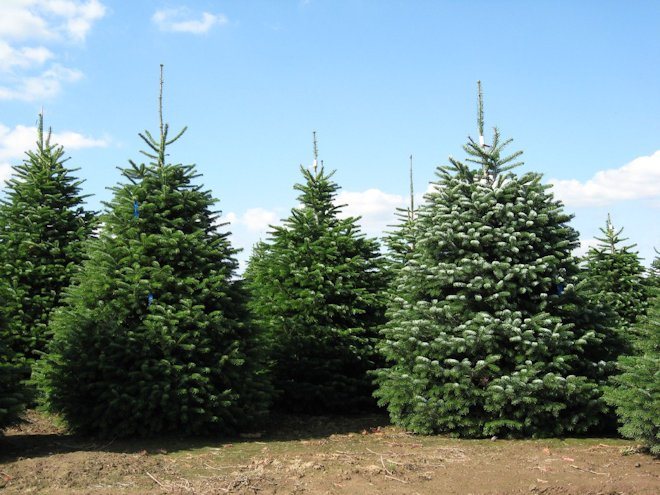
Caucasian nordmann abies nordmanniana golden sprelder
A variety that is a small bush with a depression in the crown. The culture does not exceed a height of 1 meter, it has dense needles. The peculiarity of the culture lies in the color of the needles, which are painted green at the base, and have yellow tones closer to the edge. At the same time, the inner part of the leaf blades is colored dark green. However, when growing crops in shaded areas, the plant quickly acquires a monochromatic shade of needles and loses its decorative effect. To preserve decorativeness, it is necessary to plant the plant in soil with the optimal amount of organic fertilizer.
Caucasian Nordmann abies nordmanniana pendula
“Weeping” type of fir. The peculiarity lies in the presence of hanging stems, abundantly covered with dense green needles. It is a hybrid plant that requires special growing conditions. The culture is thermophilic, it does not tolerate even small frosts. Therefore, fir is grown only in comfortable tropical conditions. Weeping fir reaches a height of 4 meters. Branches and needles hang down to form a spherical tree.
Spanish abies pinsapo
Trees, 10 to 15 meters high, with an even green crown and soft needles growing over the entire surface of the crop. Fir of this variety has several hybrids that differ in shape and appearance.
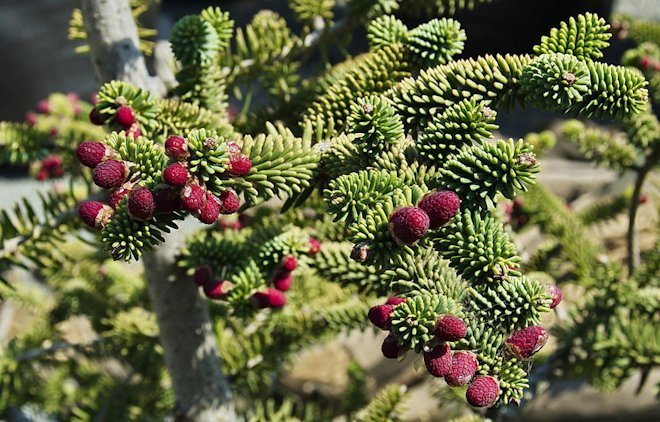
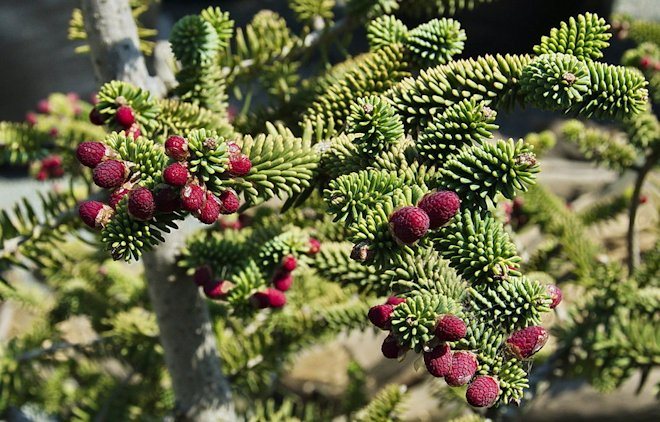
Kelleriis cultivar
A spreading tree growing in breadth, the height of which reaches 15 meters. The crown width at the bottom is about 8 meters. The tree has a fairly even outline, the crown is almost perfectly similar to the pyramid. The tree grows quite quickly, reaching its maximum size by about 50 years of age. The peculiarity lies in the unpretentiousness of cultivation. The culture grows equally well in nutritious soil and dining soil.
The crown of the tree consists of a dense spreading crown, green or bluish. The needles are quite tough and prickly. On young shoots, the needles are arranged in a circle. Female cones are quite large in size, are located vertically on the stems, and are colored brown.
Glauca cultivar glauca
Slow growing variety of Spanish fir. The peculiarity of the tree is its small and thorny needles, which in appearance are similar to the needles of spruce. If the other representatives of the species have rounded edges of the needles, this variety has sharp ends. The plant is painted in a bluish-silvery crown, hence the name of the variety. The culture is thermophilic, does not tolerate drafts and strong gusts of wind.
Tall abies procera
A hybrid type of fir, the height of which exceeds 50 meters. A culture with a flat crown and silvery needles is highly decorative.
Glauca glauca
A tall tree with a trunk up to 50 meters long, a special feature of which is the uneven distribution of stem sizes in young individuals. With age, uneven trees take the shape of a regular cone. The needles of the tree are painted in silver-blue shades. Gardeners grow the crop away from other trees in order to preserve the beauty’s decorative features.
The decorativeness of this variety is preserved even when cones appear. This variety has reddish buds growing vertically upward, which turn pale and take on a yellowish tinge as they grow. The plant easily tolerates frost, therefore it is actively grown in regions with a temperate climate.
Siberian fir Abies sibirica
Trees that inhabit the temperate and northern climate of Russia. Trees are considered the only ones that can grow outside Antarctica. Represents tall crops, more than 40 meters high. The shape of the crown resembles a narrow cone. A special feature is the narrow trunk, covered with thick cracking bark. The trunk rarely exceeds half a meter in diameter. Fir stems are also thin; in the absence of support, they go down. The branches and stems are abundantly covered with dense dark green needles that cover the entire tree. The length of the needles is about 3 cm. The tree has a fragrant smell.
Вича abies veitchii
The habitat of this species is considered to be the Far Eastern plain. Plants can be found in the form of coniferous forests or individual representatives. It is represented by tall, spreading trees, the trunk of which exceeds 25 m in height. The crown diameter at the bottom of the tree often exceeds 5 meters. If young trees have the shape of a narrow cone, then by the time they reach adulthood, the fir takes the shape of a pyramid with a wide base. The plant quickly grows to its maximum height.
A feature of the culture is the location of the needles on the branches. Situated obliquely, the needles turn face inward, showing the inner striped side. Thus, the wood has a silvery hue.

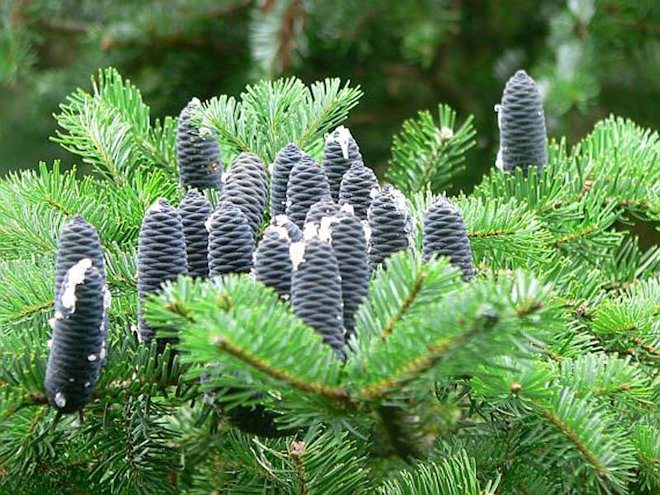
Arnold abies arnoldiana
A hybrid variety derived from the Wich and Korean fir species. The trees reach a height of 10 meters, growing in the shape of a pyramid. The branches of the tree grow horizontally to the trunk, with a slight upward slope. The crown consists of an abundance of needles, dark green in color. The needles are about 3 cm long and up to 3 mm wide, quite soft to the touch, with a rounded end. The upper part of the foliage is painted in green tones, and the lower part has light, close to white, shades.
When growing a tree in a garden environment, it is necessary to plant the crop away from other trees. The culture is finicky in its care, it requires the creation of special conditions. The culture lives only in mineral-rich soils.
White fir
Culture, up to 30 meters high, with a narrow conical trunk. The stems and twigs of the plant are covered with a smooth bark, a silvery shade. The trunk of an adult tree has cracks along the entire surface of the dense bark. A special feature is considered to be bifurcated leaves-needles, which reach 3 cm in length. The needles are dark green in color, have whitish stripes below. After the tree reaches a height of 3 meters, cones begin to form on the shoots. Female cones are arranged vertically, attaching to the stem. Young buds are colored purple, which then takes on a brown tone.
What is the advantage of container crops?
A lump with roots remains intact. This is extremely important for conifers. The fact is that on the roots of all conifers, including fir, a special microorganism lives – mycorrhiza, which helps plants absorb moisture and nutrients from the soil. When dry, this microorganism dies. If it is proposed to buy a coniferous seedling with an open root system, then in no case should you buy it. Most likely, such a tree will not take root.
The coniferous fir tree holds the record for endurance, withstands drought perfectly. Nevertheless, it must be planted correctly so that it subsequently grows well, looks beautiful, fluffy. One of the first conditions for the correct planting of fir is choosing a place. It should be well lit, sunny or, in extreme cases, light partial shade. The second condition is to properly dig a hole in which you need to plant a fir.
Care
Fir is considered an unpretentious plant, it is not difficult to grow it in the garden. However, it is important to correctly choose the optimal living conditions for the shrub in the garden. The culture requires sufficient lighting and nutritious soil. In addition, in order to preserve decorativeness, it is necessary to choose the right species that can grow in given climatic conditions.
Illumination
Fir is a thermophilic tree that requires constant sunlight. The culture is planted in sunny places. Landing in shaded areas is permissible, however, in this case, there is a high probability of loss of crown color characteristic of the species.
Temperature
It is necessary to select the temperature regime for growing fir, depending on the type and variety of the crop. Heat-loving varieties are grown at temperatures not lower than 18 degrees. Whereas frost-resistant varieties feel good at temperatures of 15-17 degrees in summer. In winter, the temperature regime is also observed. Heat-loving species require additional shelter when planting in temperate climates.
Air humidity
Fir is considered a drought tolerant tree. However, juveniles require optimal levels of humidity in the air. The plant feels comfortable with a humidity of about 60%. Therefore, in its natural environment, culture often lives along the banks of rivers and at the same level with the sea.
Watering
The tree does not need constant watering. For moisture-loving varieties, 2-3 waterings per season are enough. Plants that are resistant to the amount of water in the soil are watered only during prolonged drought. In this case, 20-30 liters of water are introduced under the plant. For other types of fir, watering is not required.
Fertilizer
Fir only grows in nutrients containing sufficient minerals in the soil. After 3-4 years in the soil, mineral fertilizers are applied under the tree. Top dressing must be applied in the spring in liquid form.
Soil mixture
To plant the plant, you must choose a well-drained soil with a sufficient amount of minerals. Loamy soil is considered the best place for fir planting. The soil must be neutral in acidity. The top layer should consist of mulch, in the form of a layer of peat, sand and fine sawdust. This soil composition prevents the soil and roots from drying out, leaving moisture inside the soil.
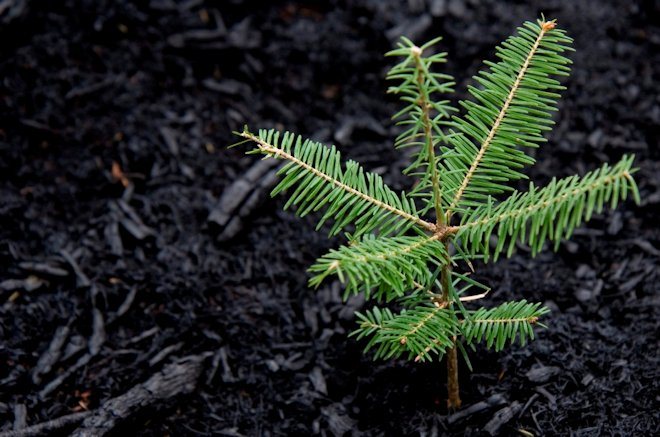
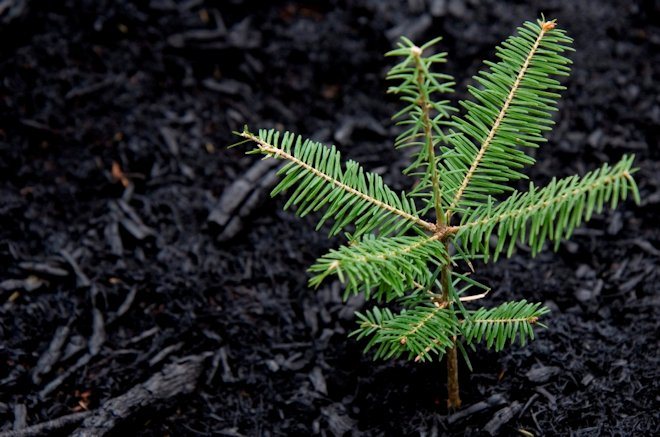
Transfer
The culture does not require transplantation. Long roots and the size of an adult plant will not allow you to painlessly transfer the culture from place to place. Plants can be transplanted only until they reach 4 years of age. At the same time, the culture is carefully dug out of the soil without damaging the roots. A hole is prepared in advance, consisting of a drainage layer and loamy soil. After planting, the soil is compacted, and a layer of mulch from sawdust and peat is created on top.
If it is necessary to transplant more mature plants, a year before transplanting, they pass around the plant with a shovel. At the same time, the soil and roots are bayonetted at a distance of about half a meter from the trunk. After a year, the plant is placed in a new habitat. When transplanting, it is important to preserve the earthen lump preserved on the roots after being removed from the ground.
Flowering
The plant does not bloom. The green fir crown has decorative qualities.
Trimming
Pruning is for sanitary purposes only. In the spring, after the snow melts, before sap-excretion begins, dry stems and needles are removed.
Fir garden care
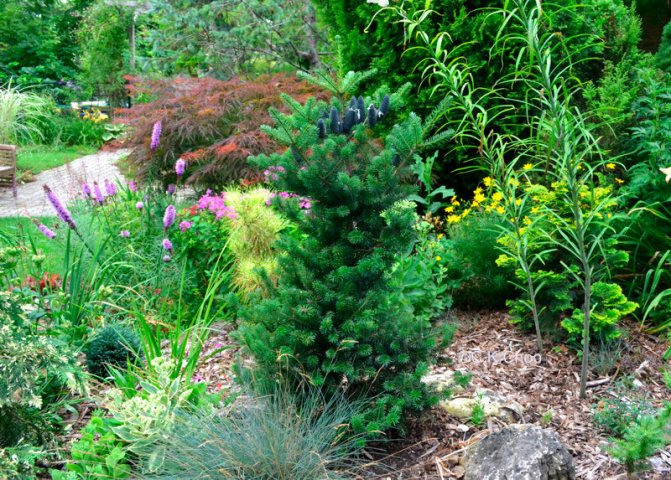

After each watering, loosening of the soil is required no more than 10–12 centimeters deep, and it is imperative to remove weeds. In young trees, it is recommended to sprinkle the trunk circle with a diameter of half a meter with mulch (sawdust, wood chips or peat). The mulch layer should vary from 5 to 8 centimeters. When doing this, make sure that the root collar of the plant is free of mulch. The planted fir will need to be fed only after 2-3 years; this should be done in the spring, by adding 100 to 125 grams of Kemira-wagon into the soil of the trunk circle. Only moisture-loving fir species require watering. For example, balsam fir needs to be watered 2 or 3 times during the whole season, but only during drought. For one watering, you need to pour 1,5–2 buckets under each tree. Other species do not need to be watered, since they react extremely negatively to waterlogging, and natural precipitation is quite enough for them.
Trimming
Pruning is carried out in the spring before sap flow begins, while all dry and injured branches must be removed. And at this time, you can, if necessary, start shaping the crown. Garden shears are used for pruning. It should be remembered that during one haircut, the stem can be shortened by no more than 1/3. As a rule, the crown of such a tree is very neat and does not require shaping.
Transfer
Conifers, when compared with other plants, tolerate transplantation quite well and quickly take root in a new place. In the event that a young plant is transplanted, then it is necessary to pierce the soil in a circle, stepping back from the trunk from 0,3 to 0,4 meters, using a sharp shovel for this. Then, with the same shovel, it is necessary to pry the designated circle, immersing it in the soil to the depth of the bayonet. The fir is taken out together with a clod of earth and transported in a wheelbarrow to a new landing site, while it should be placed very carefully in the landing hole.
If the fir has already grown, then before proceeding with the transplant, it is prepared. To do this, the soil is pierced in a circle 12 months before the intended transplant, while the trunk must be retreated more than in the first case. Within a year, the tree will grow young roots inside the designated circle, which will allow it to easily transfer the transplant. It should be borne in mind right away that one person may not be able to cope with the transplant of the grown fir, so find yourself an assistant in advance. It is very important not to allow the earthen lump to collapse during transplantation.
Pests and diseases
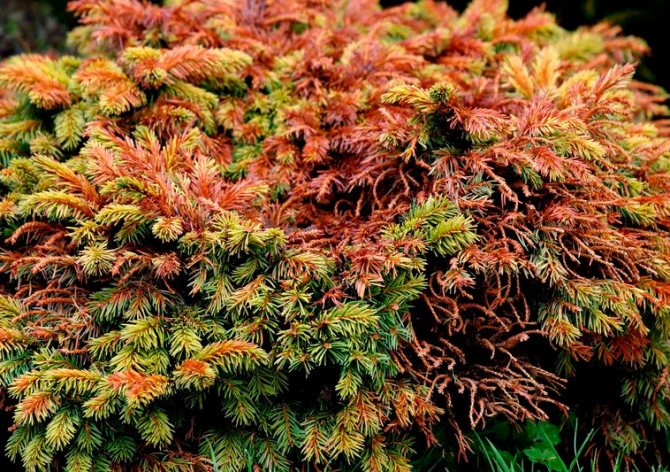
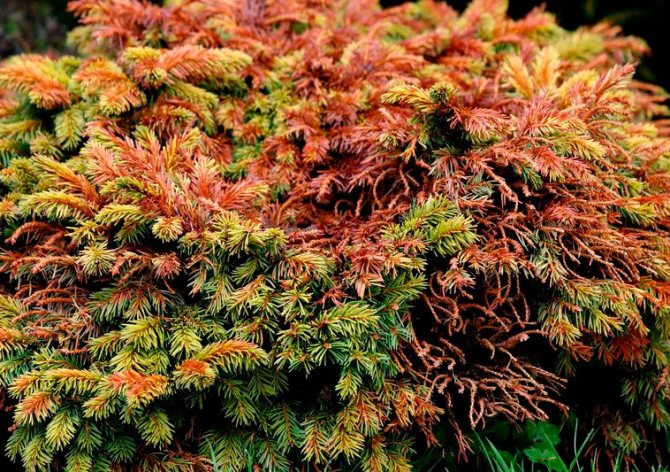
There is nothing difficult in planting and growing fir. This plant is also characterized by a fairly high resistance to diseases and harmful insects. However, sometimes it can begin to turn yellow, due to the fact that Hermes (a type of aphid) settle on it. To destroy such pests, use Antio or Rogor. At the beginning of spring, the female Hermes awakens, and it is at this time that the plant must be treated with a solution of any of these funds, while 20 grams of the drug is taken in a bucket of water. Also, these drugs will help get rid of such pests as pine cone leaf roll and fir shoot moth.
In some cases, this tree begins to turn yellowing of the needles, while rusty pillows appear on the stems. This indicates that the fir is infected with a fungal disease such as rust. Infected branches need to be cut and destroyed, as well as the needles that fell off, then the cutting sites are processed using a garden pitch. The crown should also be processed and for this, a solution of Bordeaux liquid (2%) is used. Take a good look at the area where the fir grows, if there is a starfish or chickweed on it, then these plants must be dug up and destroyed.
Fir / fir planting / fir care
Composition
The chemical composition is very rich. The plant contains an abundance of various elements, on the basis of which nutritional components for medicines are obtained. Different components are found in each part of the plant.

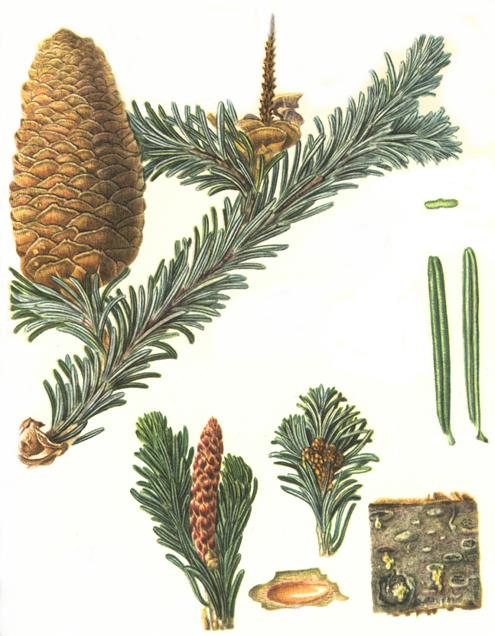
Fir needles
The needles and young shoots, to which needles are attached, contain essential oil. The oils contain substances such as bisabolene, bornyl acetate, camphene and ampinene. This structure allows you to create a fir balsam, consisting of resins and essential oil. This remedy is contained in some medicines – turpentine, diterpene alcohol. The needles contain elements such as phytoncides, vitamin C and beta-carotene.
Fir cones
The composition of young fir cones contains vitamin C. Also, the chemical composition of fir contains tannins, carotene and essential oil. Tocopherol is also present in the buds. This chemical composition allows the plant to be used to eliminate inflammation and pain.
Bark
Dried fir bark contains tannins and essential oils. In addition, the bark is the source of the formation of resins, which are also abundant in the composition of the tree part. The bark contains elements such as santen and borneol. In addition, the value of the bark is due to the content of camphor oil in the composition.
The liquid secreted by the bark is called sap, which consists of resin and essential oil. The elements contained in the bark of fir have a high antiseptic effect.
The roots
Fir roots also contain an essential oil of camphor, safrole and cineole. In addition, compounds such as camphene, camphorne and organic acids, which have high medicinal properties, were found in the composition of the roots of fir.
Proper planting of fir and watering
Try to plant the plant vertically. The soil around the stem of the seedling should be tamped down a little with your hands to settle any voids that may have formed during planting. You can form a side from the ground around the plant so that the water does not spread during watering. Immediately water the plant well. This should be done from a watering can or a hose, putting your hand under the stream of water so that the soil does not erode.
You can pour water directly on the top of the fir, on the twigs – conifers love this very much. Water the seedling three times, allowing the water to be absorbed into the soil each time. In total, you need to pour about a bucket of water.
The first watering is very important for the survival of the plant, which must be saturated with moisture. In addition, all the voids that still remain in the hole are gradually filled with heavy, moist earth.
Fir propagation
Fir can be propagated in two ways. Hybrid plant varieties are grown from seeds. Wild crops can be bred with young cuttings.
Growing fir from seeds
To grow fir from seeds, you need to collect fresh ripe buds. It is quite difficult to do this in tall plants, since the female fruits of the tree are located mainly at the ends of the branches growing closer to the top. Some gardeners recommend buying seeds in stores, but the germination of such seeds is low. If you managed to get a slightly unripe cone, you can dry the seeds and put them in the refrigerator for stratification. Such seeds germinate quite well.
Seeds are planted immediately in open ground, immediately after the snow melts. In April, the seeds are placed in moist, loose soil. To obtain fast shoots, the sowing site is covered with a film or covering material.
Under optimal conditions, seedlings appear about 14 days after sowing. Immediately after this, the film is removed and the plant is provided with optimal care. For the winter, the sprouts are left covered with a layer of spruce branches or dry foliage. For the first 4 years, the plant grows very slowly, reaching a maximum of 40 cm in length. However, the grown trees quickly gain strength and actively grow in growth in the following years.

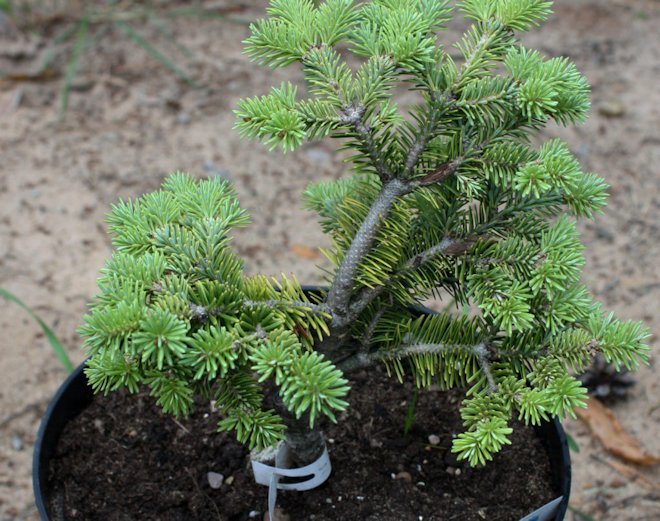
Fir propagation by cuttings
To grow fir using cuttings, you need to take a young tree, from which several cuttings are cut in the spring, up to 10 cm in size. Small shoots with one apical bud and heel are chosen as cuttings. Therefore, it is recommended to pluck the twigs from the tree, and then remove the burrs from the heel formed.
The resulting cuttings are soaked for several days in a solution to prevent fungal pathologies. Then the sprouts are placed in a peat-sand mixture and covered with a bottle or cap. For faster germination, pots with cuttings are heated to 25-27 degrees. The cuttings should be in a bright place. Periodically, the caps are removed, allowing the plant to air.
In winter, cuttings are placed in a dark, cool place with high humidity. Under normal development, cuttings take root only 2 years after planting. After the appearance of new buds, the plant can be planted in a new place.
Working with the drainage layer and plant feeding
The drainage layer is lightly covered with earth. After that, the depth of the hole should be measured again, whether it is suitable for a seedling or not, not forgetting to use the handle of a shovel. If everything is in order, then a little mineral fertilizer can be applied to the layer of earth covering the drainage, one hundred grams will be enough. After that, be sure to mix the soil so that there is no direct contact of the fertilizer with the plant roots.
We place the seedling in the hole and fill up the open space around the roots. It is good if you use a special mixture for this:
- Sod land – 3 parts.
- Sand – 1 part.
- Peat – 1 part.
Diseases and pests
Fir rarely gets sick. However, with improper tree care, various difficulties can arise. So, one of the most popular problems in growing fir is the formation of fungus on the roots. This is due to high humidity and moisture stagnation in the roots. The plant should grow in well-drained soil. At the same time, the needles turn yellow and wither quickly. You can fix the problem by treating the culture with a fungicidal solution.
Rust can be dangerous for fir. The cause of this condition is a fungus formed on the roots and trunk of the tree. It is necessary to solve the problem quickly, as soon as the first signs appear – the needles turn brown. You can get rid of rust by treating the tree with a solution of vitriol diluted with water in a ratio of 1:10.
In the dry season, the plant may lose its decorative appearance due to the formation of burns on the needles. You can solve the problem in small species by creating partial shade for the plant for the period of drought. Adult plants cope with the problem on their own.
Among the pests of fir, moth and spider mite are distinguished. Symptoms of the lesion are the formation of yellow spots next to the needles. You can fix the problem by treating the crop with an insecticide. It is also recommended to remove damaged parts from the plant.
Contents:
- Fir Brilliant
- Blue Standard Fir
- Пихта «Бревифолиа» («Brevifolia»)
- Dark Hill Fir (Dark Hill)
- Oberon fir (Oberon)
- Пихта “Зильберцверг” (“Silver Dwarf”)
- Fir “Cis” (“Cis”)
- Tundra (Tundra)
Homeland of this type of fir is South Korea, but it quickly spread throughout the world, and new beautiful varieties have appeared. Breeders love Korean fir and today there are dozens of varieties, among which we have selected the most popular and beautiful ones.
Application
Fir is not only a beautiful tall tree with high decorative qualities. Culture is used in various areas of human life, including in everyday life, folk medicine. The plant has beneficial properties, therefore, it is included in the composition of official medicine as a medicinal one.
What pathologies does fir help with?
The chemical composition of fir determines the use of the plant for the treatment of many pathologies. On the basis of culture, not only folk remedies are made, but also drugs for traditional medicine. There are many indications for the use of drugs with fir. So, the use of fir is justified for the following pathologies:
- Pneumonia of varying severity;
- Inflammatory pathologies of the respiratory tract – bronchi, larynx, trachea, oropharynx and nasopharynx;
- Angina;
- Viral infections;
- Runny nose and sinusitis.
In addition, the plant is used to treat skin pathologies – psoriasis, fungus. The effectiveness of the plant is also noticeable in the treatment of pathologies such as angina pectoris, high blood pressure, collapse, arrhythmias. The plant helps to cope with rheumatism and glaucoma.
Some parts of the fir have a calming and tonic effect, therefore they are indicated for overwork, stress and neuroses. The oil obtained on the basis of fir has a healing effect and is used to treat wounds and burns. The oil is able to quickly remove tissue swelling, with the formation of acne and boils.
In medicine
Several traditional medicines used in medicine have been created on the basis of the plant. Thus, fir extract and oil, as well as camphor, are obtained from fir.
Fir oil
Possesses antibacterial properties. The oil tones, stimulates, helps to cough up, heals wounds and relieves inflammation. Medicinal raw materials are used to treat pathologies of the respiratory system, heart and vascular diseases. In addition, fir oil helps to deal with external skin problems.
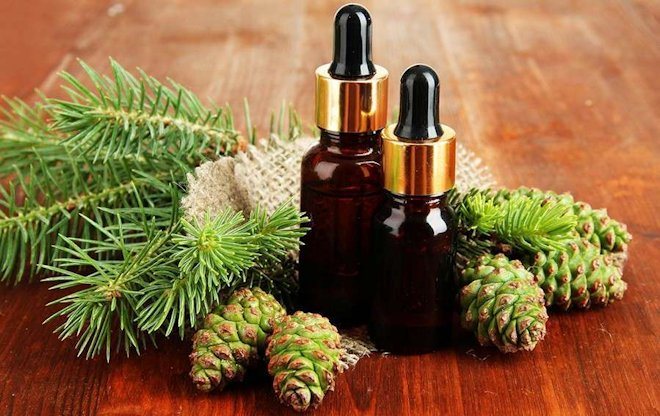
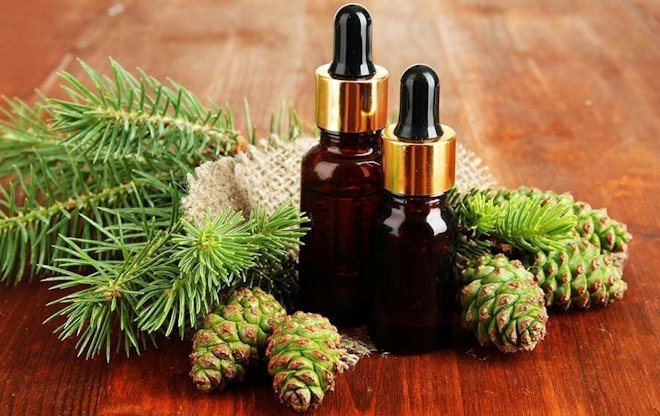
Fir extract
It is used to improve the general tone of the human body. helps to increase resistance to bacterial infections. It is a natural prevention of the development of oncology, and also improves the condition of a person with alcohol withdrawal. The plant helps to increase potency.
Camphor
The medicine is used to stimulate the heart. In addition, camphor is able to regulate the functioning of the heart and central nervous system.
At home
Fir is a valuable plant that is used for industrial purposes. In addition, in everyday life, culture is used to disinfect indoor air. Fir thinns the smell that repels insects. In addition, essential oils help prevent harmful airborne infections.
In some regions of Russia, fir is used as a raw material for bath brooms. With proper preparation of the brooms, the needles do not prick and are a pleasure. In addition, such procedures replace massage and have a tonic effect. Also, brooms help to increase the blood circulation of tissues, the central nervous system and the work of the heart are normalized. A park with fir brooms helps to cope with various viral pathologies.
In folk medicine
Fir is most widely used in alternative medicine. On the basis of the culture, infusions and decoctions are made for the treatment of ailments. Raw materials have found their use in cosmetology.
Fir oil for scalp and hair
Containing enough vitamins and minerals, fir oil helps to improve the quality of hair. For this, a cap of oil is mixed with shampoo, and then used in the usual way. It is proven that the oil removes increased greasiness and oily hair, fights dandruff and other scalp rashes.
Broths and infusions of fir needles
Fir needles have long been used as a medicinal component in the treatment of various diseases. Decoctions and infusions of fir oil help to solve problems with diseases of the lungs and oropharynx. Taking decoctions and infusions is useful for people with heart problems. Decoctions help cleanse blood vessels, and the infusion has a tonic and strengthening effect.
A decoction of pine needles is prepared as follows: 5 tablespoons of dry raw materials are poured into 100 ml of boiling water. The resulting mixture is boiled for half an hour. The compress obtained on the basis of cooking is used for external use. In addition, a decoction of live needles, prepared in a similar way, is used orally, half a glass 5 times a day.
For the treatment of pathologies of the lungs, the following decoction is made: the bark of the fir is crushed and dried. Then 1 tbsp of raw material is poured with 200 ml of boiling water and cooked for 10 minutes. The resulting raw materials are used in strained form 4 times a day for a quarter of a glass for 20 days.
Fir in landscape design
Fir is in demand in landscape design, since a variety of varieties allows you to grow a decorative tree with an unusual color on the site, which does not cause any trouble to care for. Low-growing trees are used to decorate rock gardens or garden paths.
Use in landscape design
The variety of varieties of Korean fir allows its wide use in landscape design. It looks great in groups with other plants, shrubs and flower arrangements, in single plantings. Korean fir perfectly coexists with maple, larch, pine and spruce. It is often used as a green hedge, a component of an alpine slide, a rocky garden. Coniferous plantings of different shades of Korean fir can become a real decoration of parks and squares, emphasizing the beauty of one another while choosing the correct location for each specimen. Compositions are created from dwarf varieties of various shapes and colors in combination with flowers, thujas or deciduous shrubs.
Gardeners also chose Korean fir for its unpretentiousness, variegated, unusually beautiful color of needles and blue cones-candles that adorn the tree all year round. Recreation areas are created with fir trees, and in combination with deciduous trees, beautiful compositions.
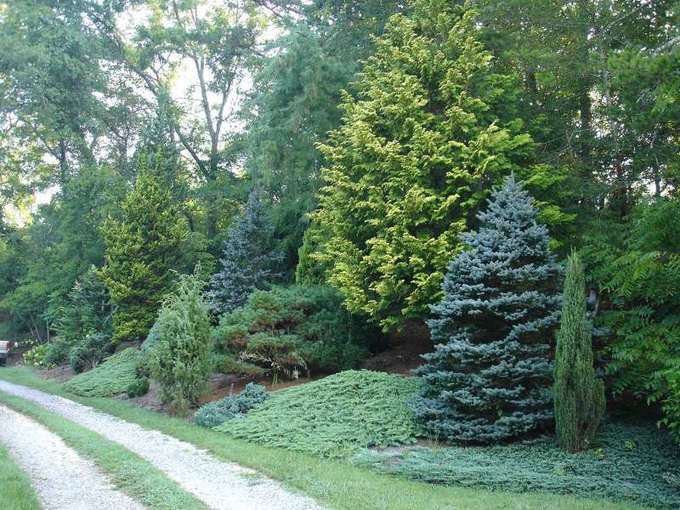

The Korean fir is a very slow-growing tree, so you can make unusual sculptures from it by properly pruning it. Fir will retain its desired shape for a long time and will become an object of admiration and increased attention. The longevity of this plant also plays into the hands of gardeners and designers, because beautiful compositions can be preserved for many years without fear that some of the components will lose their attractiveness. The main thing is to regularly look after the plantings, constantly carry out the prevention of diseases, timely prune dry and diseased branches, fertilize and water the fir plantings. Observing all the rules for caring for plants, you will be rewarded with a beautiful and bright coniferous kaleidoscope of various varieties of Korean fir.
